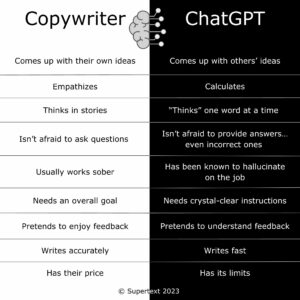With all the fuss about ChatGPT and AI, you could be forgiven for thinking that translators and copywriters are facing certain extinction. But what do large language models (LLM) really mean for our beloved industry?
Five days. That’s how long it took for OpenAI’s ChatGPT to reach a million users. And it didn’t stop there: according to analysts, the service hit 100 million just two months later. These incredible stats put even industry-shaking giants like Instagram (1 m users in 2.5 months), Spotify (5 months) and Netflix (3.5 years) in the shade.
So while we can laugh about ChatGPT and other large language models’ hallucinations, biases and natural-sounding yet nonsensical content, that won’t stop them from dramatically changing the world of communication – which includes the language industry.
In fact, this transformation is long since underway. Browsing the internet, you’ll now find everything from job postings for “AI Editors” – with the successful candidate expected to produce 200 to 250 articles per week – to reports that “AI is tearing Wikipedia apart”. Meanwhile, in the translation sector, there are already plenty of use cases where LLMs appear to significantly outperform the major MT engines.
Welcome to the age of abundance! Now that content can be produced and translated into any language in seconds, every company, brand and marketer can flood the world with words. If you already felt like a tiny fish in an ocean of content, you might want to start thinking about yourself as a single piece of stardust in an entire galaxy.
Where does this leave us? While alarmist headlines – and our own concerned parents – suggest that copywriters and translators have just taken a major hit, this could in fact be a blessing in disguise. Because one thing is for certain: the world of content is entering an up-or-out phase. People will become increasingly lost in that galaxy of (at best) average content. More than ever, they’ll be looking for brands that are thought-provoking and dare to be different. And human creativity will be the decisive factor in this race to the top.
Great Writing Isn’t About Writing. It’s About Thinking.
Having a heart doesn’t make you a cardiologist. And putting pen to paper doesn’t make you a wordsmith. Only the gifted can craft content that’s truly persuasive and leaves an impression. So, what is it that sets the great writers apart? Funnily enough, it’s very rarely the actual writing.
Just do it. I’m lovin’ it. Think different. Almost all of the greatest ads and slogans could have been written by a 10-year-old. They aren’t great because of their lyrical prowess, but because they get into our heads. They make us stop for a second – and that in itself is one of the greatest challenges of our time.
How do they do this? By providing insights people hadn’t thought of themselves. By concisely presenting use cases and benefits. By framing people’s needs in a new way. And sometimes by being disarmingly honest and vulnerable. There are many roads to success, but all of them are human to their very core.
Mediocrity. Now 500x Faster.
ChatGPT and its friends take a profoundly different approach from a writer or transcreator making a genuine connection with the reader. They don’t understand or think. They simply generate, repeating ideas that are in their dataset rather than coming up with new ones. And that data comes from all over the place – which is also how you might describe the quality of the output.
For low-visibility content at high speed, an LLM might just be the right tool – good enough for a lot of use cases, but definitely not a dealmaker. For anything that goes beyond that, it’ll still be humans playing the starring role.
The True Revolution: Combining Human Brilliance With the Efficiency of AI.
 Doomsday scenarios for the language industry are nothing new: we’re used to receiving condolences from our friends and family every time a new machine translation tool is released. And yet here we are, creating and localizing content as passionately as ever. Because coexisting with machines is not only possible, but profitable – if we choose to embrace it in the right way.
Doomsday scenarios for the language industry are nothing new: we’re used to receiving condolences from our friends and family every time a new machine translation tool is released. And yet here we are, creating and localizing content as passionately as ever. Because coexisting with machines is not only possible, but profitable – if we choose to embrace it in the right way.
Drawing on our copywriting and transcreation experience, we at Supertext have spent the last few months experimenting with generative AI. And we’ve learned first-hand how differently human professionals and tools like ChatGPT approach a writing task:
Sure, it’s a little tongue-in-cheek, but the conclusion is still crystal clear: combining human brilliance with the efficiency of AI is the way to go for both content creation and translation.
As with any tool, an LLM’s output is heavily dependent on the input it’s given. Figuring out how best to prompt it might be what defines the great wordsmiths of the 21st century: it all comes back to creativity. Add editing skills on top to iron out the output’s bumps, and language professionals are looking at a very bright future.
Change is Upon Us. Let’s Do it Right.
The best way to embrace the new tech obviously looks different depending on what vertical you are in. LLMs might become a go-to productivity tool for medical, legal or sworn translations, but consumers will still want the reassurance of knowing a human professional was involved to ensure accuracy and consistency across language barriers.
When it comes to more creative projects, though, users rarely care about the source text, or even whether a piece of copy was translated at all. All that matters is whether it makes the right impact on its target audience – and that’s something that good copywriters have excelled at from day one. Here’s how to take a page out of their book and make the most of ChatGPT’s capabilities:
Step 1: Get rid of the source text constraints
Let’s face it: most translation projects, even the ones that call for creativity, currently take place in rigid environments like Trados. A copywriter, on the other hand, usually starts out with no more than a blank page. The only limit is their imagination.
Step 2: Or maybe get rid of the source text altogether?
Generative AI opens up entirely new pathways for multilingual projects. Why not try kicking things off with a monolingual source prompt (aka the briefing) instead of a source text? If you prompt the model to create original content in each target language, every text will be different – and, in many cases, better suited for the target market’s needs. And isn’t that what we’ve wanted all along? Clients currently tend to choose translation over multilingual copywriting because of its lower price. But with LLMs in play, this isn’t necessarily the case anymore. So why not make use of it?
Step 3: Keep experimenting
Generative AI moves fast, and by the time you’re reading this, these approaches might already be outdated. The most important thing is to stay open to new strategies and keep your imagination and writing style sharp. Because the translator of the future might just be a copywriter.
No Doom, Full Bloom
Finally, success always comes down to the right mindset. It’s important to remember that there’s a reason why the language industry has persisted – and even flourished – through generation after generation of new technology.
What we do is, at its core, very human. Disruptors and robots may be capable of producing vast numbers of words in the blink of an eye, but really connecting with the audience takes emotion, inspiration and personality. Getting inside the reader’s head and finding the perfect phrase to capture a message is something AI won’t be able to do for a long time yet.
This is what will set us apart. It will challenge us to work even harder to find ideas worth writing about in the first place. And, ultimately, it will make us more human than ever.
 Hello there! I’m Fabio, and I run the marketing department at Supertext, a LSP focused on (multilingual) copywriting and transcreation for marketing and advertising.
Hello there! I’m Fabio, and I run the marketing department at Supertext, a LSP focused on (multilingual) copywriting and transcreation for marketing and advertising.
With a background in communications and marketing, I have entered the language industry from the creative side myself and am obsessed with all things writing and reaching superior content quality at scale.
Thus, I’m fascinated with the rise of large language models like GPT-4 and the like and looking for ways to integrate them into processes not only to be faster, but also better in terms of quality.
I’m happy to connect on LinkedIn!
